Collaborative task management: Guide for beginners, 6 free task management software in French
6 free task management software available in French
And now ? Consult our catalog of task management tools to find the tool you need.
Task management
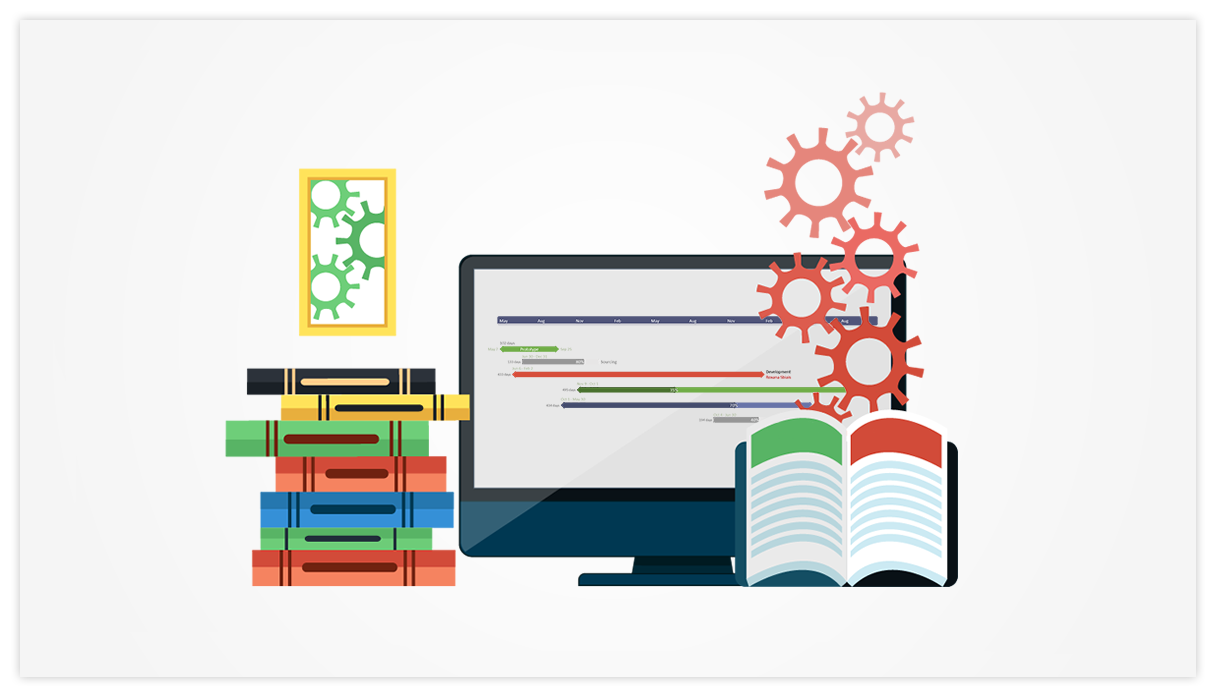
Task management constitutes the foundation of the discipline of collaborative project management. Well done, it provides organizations with an efficient work flow process which becomes the main vehicle for the delivery of all their collaborative projects. Task management is not easy, but, with an appropriate system in place and the right task sharing applications and the right monitoring tools, professionals can guarantee the smooth running of their projects from start to finish.
On this page, we will present the basics of collaborative task management, definition, importance and methodologies, to free collaborative task applications and tools to organize and follow the tasks of the project. Read the complete guide or use the links below to directly access the chapter that interests you.
- 1. Introduction to task management: definitions
- 2. Why is task management important?
- 3. How do task management and project management differ?
- 4. Task management methodologies that work
- 5. Task management tools: free models and software
- 6. Task management terminology
Introduction to task management: definitions
What is a task
The tasks are all the work elements and the tasks that must be performed in a time defined for a collaborative project to be completed. Project management teams are approved to effectively manage these tasks throughout the project. This often requires coordination with other teams and people, as well as orchestration of all previous and future tasks deployed via effective workload management tools.
Elements of a task
Project managers create GANTT diagrams to help manage and share the tasks of the project. Each task has a title or description, a start date and an end date, and it may also include details such as the owner of the task or the percentage completed. Usually, the tasks are placed in order on the Gantt diagram, depending on the activity which must be completed before others can start.

- 1 start date
- 2 end date
- 3 Description of the task
- 4 % completed
- 5 Duration of tasks
- 6 Task owner
What is task management
The task management is to manage a series of tasks until their completion, as defined by a project calendar. It is the process of progression of each task throughout its life cycle, from the creation phase to the completion and the reports.
Project managers follow systematic task management processes to manage all aspects of tasks. These processes include the sharing and allocation of tasks, deadlines and lists of shared tasks, hierarchy, budgeting and state communications, among others.
Why is task management important?
When you work with teams, good task management is the key to productivity and harmony at work. It offers a structure and clarity, giving everyone a list of shared tasks and a detailed view of all the mobile parts of a collaborative project and the way they overlap, especially for those who need to cooperate at -the geographic borders.
With today’s prolific development of various project management tools in project management, working together has become easier than before. This has given a new dimension to the way in which the projects distributed and complex are executed, making tasks more dependent on the collaborative workflow and collaborative task lists.

Given that collaboration modifies the operation of companies, good tasks management practices and project collaboration tools help define a common task list to share which allows members of the team:
- Know their priorities at any time
- remain synchronized
- Maintain a balanced workload
- Respect their deadlines successfully
Above all, know exactly what to be done, when and in what order will also reduce the levels of anxiety and stress at the workplace.
Want to plan, share and collaborate in real time?
Consult our free online chronology creator. A simple web application, it allows you to easily create professional PowerPoint slides that you can quickly update and share online. Invite your colleagues to modify your plan and make team collaboration a safe and effortless process with Office Timeline Online.

How do task management and project management differ?
Task management is closely linked to project management and is an integral part of it. This is why the two concepts can be easily confused. However, task management does not replace project management and there are significant differences between the first and the second.
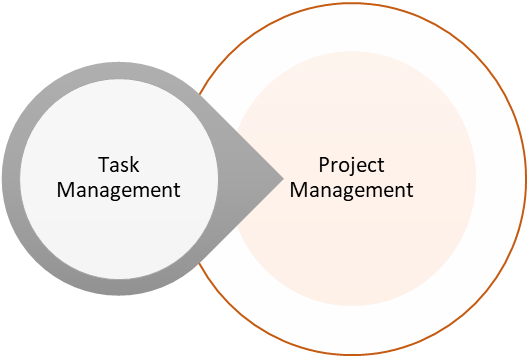
Task management can be a short -term, long -term or permanent process. This implies the use of specific techniques, tools and software to decompose the objectives of the organization or project into tasks, assign the deadlines and members of the team and follow the progress.
Project management, on the other hand, does not imply permanent aspects of the company. This is a temporary process that always has a completion date and very precise success criteria – a service, a product or a functionality with a defined start and end and delivered within a specific budget.
While task management oversees only aspects related to tasks, project management encompasses all the details that have a point of contact with a project, including strategic planning, budgeting, resource management, documentation and documentation and , of course, the management and monitoring of tasks.
Task management methodologies that work
There are several main approaches to manage the tasks of a team. Although many popular methods have been designed for software development projects, they can also be successfully applied in other fields. In fact, they can be among the most effective techniques, as they were designed by professionals who desperately needed to work quickly, stay organized and deliver in time.
Here are some commonly used task management systems explained.

1. Cascade
One of the most traditional task management methodologies, cascade is a linear approach that requires in -depth planning. The tasks are defined upstream and performed in sequence, each phase to be completed before the next one can start.
With carefully planned work and delivered in a single cycle, the cascade system has the advantage of being predictable and very simple, but it does not offer much flexibility. This is why it is ideal for major projects that require respecting strict deadlines or for repetitive activities that are unlikely to surprise you along the way.
2. Agile task management
Although often described as such, Agile is not exactly a task management technique, but rather a philosophy or a set of principles, initially designed for software development projects. The four main values described in the agile manifesto are:
- Individuals and interactions on tools and processes
- Respond to change in relation to the implementation of a plan
- Customer collaboration on contract negotiation
- Work software on detailed documentation
With Agile, the teams run through the planning, execution and evaluation processes as and when. The project tasks are designed and adjusted according to the situation, rather than having engraved everything in marble from the start as in the Waterfall system. This makes agile best suited to increasing projects or objectives which have a higher level of unpredictability and complexity.
3. Scrum task management
A form of agile task management, Scrum recommends allowing a small self-organized team to define roles and responsibilities and to prioritize tasks. In Scrum, there are fixed duration iterations called sprints which last one or two weeks, at the end of which the team must deliver specific segments of the project and plan the next iteration.
This task management method offers flexibility and allows the team to have a clear overview of the project state, which allows them to accurately judge the obstacles that can slow them down. However, there is a good chance of failure if all the people within the team are not sufficiently experienced, cooperative and engaged in work.
4. Kanban task management
Like Scrum, Kanban focuses on self -managed teams and the first versions. Lighter on the processes, Kanban is visual and flexible, has no prescribed roles and aims to improve results by increasing the concentration of the team on tasks that really matter. The system is ideal for small teams working in contexts where tasks priorities can often change – for example, maintenance or operational environments.

The model uses a Kanban table To represent the different stages of development and Kanban cards To represent the tasks of the work process. In its simplest form (illustrated above), the structure of the table has three columns:
The sheets are moved through these columns as work on tasks is progressing, brushing a clear table of the workflow process and allowing everyone to see what will follow. This facilitates the redefinition of priorities, limitation of current work, blocking prevention and early detection of problems.
5. GTD task management
Created by the productivity consultant David Allen roughly when Agile appeared, GTD (Getting Things Done) stormed the world during his first publication. It is a system for capturing ideas and tasks management based on the principle that “the head is to have ideas, not to keep them”. The method aims to unclutter the mind and improve productivity by transforming ideas into physical actions. Here’s how it works:
- Collect All the tasks that must be performed at any time, adding more tasks to the list when they enter.
- Clarify And organize Tasks. What cannot be the subject of an action will be moved to a “basket” list, while what can be done in less than two minutes should be done immediately. Whatever the tasks that take more time, they will be hierarchical and planned, and those that require several actions will be broken down into smaller and easier to manage pieces.
- Review often. Reserve time to examine and update the task lists at least once a week is essential to the efficiency of the system.
- Hire. Choose your next task and take action. The system should facilitate this, because the tasks are classified, hierarchized and divided into small pieces that are easy to start.
Although at origin intended for the management of individual tasks, GTD can also successfully operate in team environments. He will provide a common “language” and a set of principles to the whole team, while allowing members to implement these principles in the way that suits them best.
Which task management system to choose?
The choice of a task management method depends on various factors, the complexity of the work, the flexibility of the calendar and the involvement of stakeholders at the size, the culture and even the aversion to the change in the team. Usually, to find the right adjustment, managers do not make the decision alone – they collaborate with team members to select the approach that will bring the most advantages to everyone.
One thing to remember here is that the task management systems presented above do not exclude each other – they can be successfully mixed to adapt to the particularities and preferences of each team. Here is an example of such a mixture:
- Agile principles can be used as a general state of mind to progress quickly.
- GTD can be applied to define, organize and prioritize tasks.
- Kanban can be used as a way to view and follow the tasks.
Want to plan, share and collaborate in real time?
Consult our free online chronology creator. A simple web application, it allows you to easily create professional PowerPoint slides that you can quickly update and share online. Invite your colleagues to modify your plan and make team collaboration a safe and effortless process with Office Timeline Online.

Task management tools: free models and software
Simple calculation sheets with complex, various resources management management software is available to help professionals manage tasks more easily. Below, we will examine them quickly and provide some free task monitoring tools that professionals could find useful.
Task management models
Easy to document and coherent, task management models can help you save time and replicate work quickly for exams and regular reports. Generally created for popular office tools such as Excel or PowerPoint, they are familiar to everyone and do not require learning new software to maintain them.
The drawback of models is that, in the case of large and complex projects, their update can become difficult. In such cases, an option would be to import them into simple applications for monitoring tasks or task management tools that support such integrations and update them there.
Professionals working on small to medium -sized projects can find useful Excel and PowerPoint models in our gallery of free task management models . Excel calculation sheets include simple formulas and graphics to automate planning and monitoring of tasks, while PowerPoint slides are designed to be visual and easy to follow, suitable for communications with high -level audiences.

Task management software
Offering more versatility and automation than models, a well -chosen project task management tool can improve productivity and help team members and stakeholders stay on the same wavelength. The variety of task trackers available on the market today is simple shared applications to make the list to robust project collaboration software to manage major projects delivered by scattered teams. It includes online task management tools, project management software based on notifications and collaboratives, as well as a simpler free task manager and shared control list applications.
When assessing task management tools, users must first assess the size and complexity of their project. The simpler projects with small teams can find too complex business project management software, while the teams working on massive projects will most likely find simple applicables that can be unusable.
Those looking for the right medium can try the Light Timeline Light Task Manager for PowerPoint . This is a free supplement that automatically transforms the raw data of tasks into gantt diagrams and chronologies that are simple to understand, allowing users to organize, follow and update their tasks easily. In addition, the monitoring of tasks can import planning from existing Excel files and it also has a web version for those who prefer to manage their tasks online.
6 free task management software available in French
Emilie, content analyst to capture, on the lookout for the latest technological and strategic trends for SMEs. Specialized in e-commerce, fan of audio podcast and carlins.
Emilie, content analyst to capture, on the lookout for the latest technological and strategic trends for SMEs. Specialized in e-commerce, fan of audio podcast and carlins.
This article was published for the first time in May 2018, then updated in January 2023.
Organizing the various daily missions of a company can be complex. Dedicated tools, known as task management software, can however facilitate rationalization, prioritization and organization of the activities of an organization.
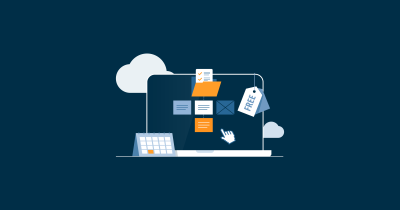
In this article
- 1. Plan your resources with free ActiveCollab free task management software
- 2. Centralize your tasks with Asana
- 3. Manage the collaboration of your teams with the Free Meistertask task planner
- 4. Automatize everyday tasks with Monday.com
- 5. Manage the progress of tasks with the concept software
- 6. Visualize the evolution of your tasks with Trello
Whether for the implementation of a punctual project or to facilitate the progress of the recurring activities of a company, having an overview of the tasks carried out represents an important advantage.
In order to monitor workflows and the course of each step, there are solutions whose functionalities make it possible to create, assign and plan the different missions involved: the task management software.
But how to choose from the different solutions offered on the market ? To help you in this process, Captterra has made a selection of 10 free task management tools whose interface is also available in French.
These solutions offer the main features of the category of task management software, ie labeling, programming, monitoring of progression as well as modification and updating of tasks.
A complete methodology is available at the end of this article.
Discover below the solutions of our selection, classified here in alphabetical order:
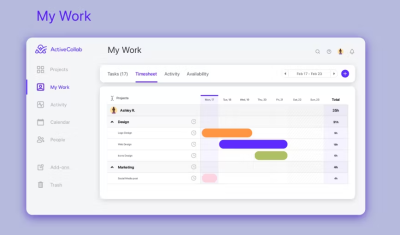
- Active collab
- Asana
- Meistertask
- Monday.com
- Notion
- Trello
- Overall note: 4.5/5
- Ease of use: 4.5/5
- Customer service: 4.4/5
- Features: 4.2/5
- Value for money: 4.5/5
The ActiveCollab tool offers a task management solution and projects that can adapt to workflows from different degrees of complexity. Based on the cloud, this tool can be deployed on Windows, Mac, Linux, or IOS and Android environments.
To facilitate the structuring of work as well as decision-making, the software allows users to manage and decompose work in tasks and subtaches, to define priorities, but also to collaborate and communicate in real time.
All data are gathered in a single space to which the various actors concerned can access, while giving the option to share the relevant documents and information.
For managers as well as for their teams, it is possible to be informed of the progression of each mission, to identify on which tasks to concentrate their efforts, as well as to assess the time devoted to each step.
Some features of the free version: The free version of ActiveCollab includes up to 3 users and 1 GB of storage, an unlimited number of projects, a timer of tasks, as well as a visualization in the form of a Kanban list or table.
Some features of the paid version : the Plus paid version includes up to 3 users and 10 GB of storage, time monitoring in terms of tasks, as well as time monitoring in terms of projects.
2. Centralize your tasks with Asana

- Overall note: 4.5/5
- Ease of use: 4.3/5
- Customer service: 4.3/5
- Features: 4.3/5
- Value for money: 4.4/5
Free task planner, Asana offers a platform to centralize missions and facilitate the organization of work between teams. Compatible with iOS and Android, this tool can also be deployed on the cloud, Windows and Mac.
ASANA allows you to monitor the parameters that make up the execution of a task: the person to whom the mission, the documentation and the information related to it, the prior priority orders, or the deadlines.
To help collaboration between the different actors and the cohesion of their work, the tool offers real -time communication features as well as the possibility of defining the roles which are attributed to the different parties.
In addition to these elements, the software also makes it possible to manage billing information, security parameters, but also to view the organization’s activities via a dedicated administration console.
Some features of the free version: The free version of ASANA includes up to 15 users and unlimited storage of 100 MB per file, an unlimited number of projects, a visualization in the form of a list or Kanban table, as well as a full journal of activities.
Some features of the paid version: The premium paid version includes an unlimited number of users, the possibility of generating reports for an unlimited number of projects, a process generator, time monitoring in terms of tasks, as well as the option to configure teams and private projects.
3. Manage the collaboration of your teams with the Free Meistertask task planner
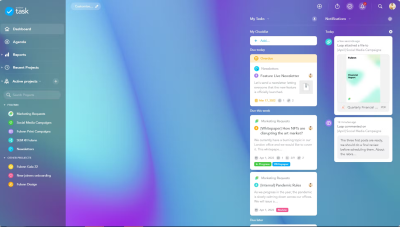
- Overall note: 4.7/5
- Ease of use: 4.7/5
- Customer service: 4.4/5
- Features: 4.4/5
- Value for money: 4.5/5
Free Meistertask free task management software allows its users to have a global vision of the tasks to be performed, using a dedicated dashboard in particular. Based on the cloud, this tool also adapts to a Windows, Mac, iOS and Android environment.
To organize tasks and centralize information, Meistertask provides its users with a Kanban style project table, as well as an organization of projects by calendar. Each employee can be informed by this, and in real time, of any update linked to the progress of tasks.
The tool provides a newspaper of activities that records the time spent by members on their mission, in order to help companies define the resources of time and people necessary for the realization of projects.
Meistertask also makes it possible to support the communication and collaboration of teams through comment features, implementation of deadlines, notifications, but also for sharing of files.
Some features of the free version: The free version of Meistertask includes up to 3 projects, an option of attached files up to 20 MB per file, an unlimited number of projects of projects, a time monitoring functionality, as well as the creation of tasks by email.
Some features of the paid version: The paid version PRO includes an unlimited number of projects, an option of attached files up to 200 MB per file, the creation of recurring tasks, the option of private projects, as well as reports and statistics.
4. Automatize everyday tasks with Monday.com
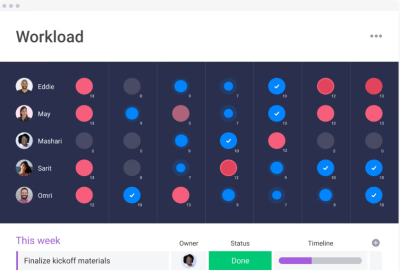
- Global note: 4.6/5
- Ease of use: 4.5/5
- Customer service: 4.5/5
- Features: 4.4/5
- Value for money: 4.3/5
Operating via the cloud and compatible with Windows, Mac, iOS and Android environments, Monday task management software.Com Association of the daily tasks of a company.
Through this platform, the members of a team can be gathered in a single table and receive alerts and notifications in real time on the progress of the project and updates. It is also possible to define deadlines for the work, as well as to store the information and documents relevant to the realization of a project.
To visualize workflows, Monday.com offers several visualizations in the form of Kanban paintings, calendar, or even schedule. A library of models is also available, including different types of workflow adaptable to different sectors.
Monday.com offers among its other features the possibility of carrying out surveys, to follow the expenses in progress, as well as team cats.
Some features of the free version: Monday’s free version.com includes up to 3 projects and 200 models, up to 500 MB of storage, up to 2 projects of projects, and is limited to 1 table per dashboard.
Some features of the paid version : the basic paid version Basic includes an unlimited number of projects, up to 5 GB of storage, an unlimited number of user billed at € 8 per user, an unlimited number of free visitors, as well as the possibility of creating a dashboard Based on 1 table.
5. Manage the progress of tasks with the concept software
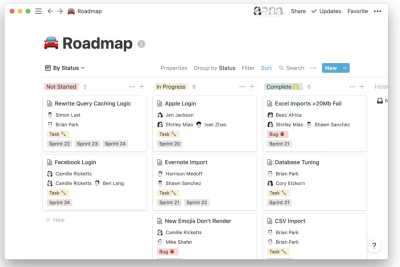
- Overall note: 4.7/5
- Ease of use: 4.3/5
- Customer service: 4.5/5
- Features: 4.6/5
- Value for money: 4.6/5
Concept offers a centralized platform via which users can organize tasks, view it, share information, or even automate the workflow to meet the specific needs of a project or a recurrent mission.
Based on the cloud, this solution can be deployed on Windows, Mac, but also on devices operating under iOS and Android. To help managers and members of a team to remain informed of the progress of a project, concept offers a collaborative space where files and meeting notes can be shared, combined with a Kanban type workflow and to a system of task lists.
Concept also offers a library of models categorized by sector and which can be addressed to different fields such as human resources, marketing, product management, sales or customer service.
In addition to these features, a concept gives its users the possibility of requesting feedback or revisions on updates and the evolution of current tasks.
Some features of the free version: The free concept version includes up to 2 members, up to 5 MB of storage and 10 guests, the option of creating dedicated work spaces, and up to 7 days of history.
Some features of the paid version : the paid version more includes an unlimited number of members, unlimited file storage and 100 guests, the allocation of roles, and up to 30 days of history.
6. Visualize the evolution of your tasks with Trello

- Overall note: 4.5/5
- Ease of use: 4.5/5
- Customer service: 4.3/5
- Features: 4.3/5
- Value for money: 4.6/5
Based on the cloud, Trello is task management software whose features allow you to manage workflows as well as team collaboration. Deployable on Windows, Mac, iOS and Android, this solution makes it possible to distribute tasks between different employees, assign deadlines as well as specific roles.
Through their interface, users can create cards to represent tasks, and organize them on a Kanban type table using a “drag-drop” type action.
Cards have the possibility of being organized by list, label or member, to identify the workload or interdependencies of tasks, but also assign specific deadlines.
Team members are informed of all changes made using alert received via the platform, as well as on the email associated with their account. The latter are also able to add new participants to the conversation using mentions.
Some features of the free version: The free version of Trello includes an unlimited number of users, unlimited storage space with up to 10 MB per file, an unlimited number of projects, up to 10 tables per workspace, and unlimited access to the newspaper D ‘activity.
Some features of the paid version : The standard paid version includes unlimited storage space with up to 250 MB per file, a number of tables per unlimited workspace, the option of adding guests without restriction, as well as a visualization in the form of a table on board.
And now ? Consult our catalog of task management tools to find the tool you need.
Methodology
To appear in this list, the selected software had to respond to the definition of task management software, which includes the following basic features:
- Task labeling
- Task programming
- Monitoring of the progression of tasks
- Modification and update of tasks
In this article, we highlighted the products offering a free version not limited in time and in French, with a minimum of 20 opinions obtained between 1/1/2021 and 1/1/2023, and a note User global 4.5 stars on Câtrara.en at the time of publication.
An objective methodology is used in order to carry out the selection and ranking of the products offered. However, some sellers can pay us in exchange for traffic on the web or leads obtained from this page.
This article may refer to products, programs or services that are not available in your country, or which can be limited by the laws or regulations of your country. We suggest that you directly consult the software publisher to obtain information on product availability and compliance with local laws.
Associated software
- IT project management software
- Task management software
- Resource software
- Workflow software
- Time management tools



